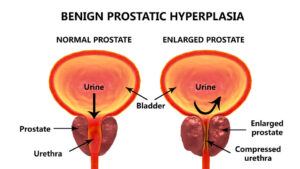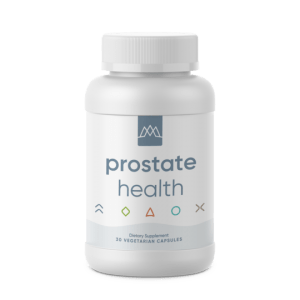What is the Prostate Gland?
 Your prostate gland is located underneath your bladder. This gland, located between the bladder and penis, lies just in front of the rectum. This location allows your body to excrete urine. (1)
Your prostate gland is located underneath your bladder. This gland, located between the bladder and penis, lies just in front of the rectum. This location allows your body to excrete urine. (1)
Your prostate creates a thick, milky-white fluid. That fluid becomes part of semen, helping sperm live longer and stay mobile. (2) In other words, the prostate also plays a key role in your reproductive system. (3)
Ideally, your prostate should be the size of a walnut or golf ball. By 40, it can grow to the size of an apricot. By 60, it might be the size of a lemon. (4)
Prostate-related Health Problems
 That increased growth as you age, along with its location, mean that prostate problems can impact urination and sexual function. Three problems can result:
That increased growth as you age, along with its location, mean that prostate problems can impact urination and sexual function. Three problems can result:
- Prostatitis. Infection or inflammation of the prostate can create problems including burning or painful urination and difficulty urinating. (5)
- Prostate cancer. According to the Centers for Disease Control and Prevention (CDC), prostate cancer is the most common non-skin cancer among American men. (6) About 175,000 American men are diagnosed every year. (7) Growth of cancerous cells inside the prostate can spread to other parts of your body. (8)
- Benign prostatic hyperplasia (BPH). An enlarged prostate, which becomes more likely as you age, can block urine flow. (9) This can result in benign prostatic hyperplasia (BPH) or prostate gland enlargement. (10) Signs of BPH include:
- Needing to urinate often
- Increased urination at night
- Trouble when you start urinating
- Not being able to completely empty your bladder.
The Importance of Prostate Health
 About 75 percent of men over age 60 have BPH. (11)
About 75 percent of men over age 60 have BPH. (11)
Especially as you get older, talking about prostate health with your healthcare practitioner becomes crucial.
He or she can discuss a number of options to measure prostate health, including a digital rectal examination, blood tests, a prostate biopsy, and a prostate ultrasound. (12)
Always discuss any specific prostate issues or issues you suspect might be related with your prostate with your healthcare practitioner, including:
- Discomfort anywhere in your pelvic or rectal areas
- Difficulty urinating
- Blood in your urine or semen (13)
6 Ways to Keep Your Prostate Healthy
While you can’t totally eliminate prostate-related issues that develop as you get older, you have plenty of control over your prostate health at any age with these six strategies.
1. Take the right preventative measures.
To reduce your risk of prostate enlargement and disease:
- Don’t smoke. (14)
- Maintain a healthy weight — being overweight or obese can increase your risk of aggressive prostate cancer. (15) Our Core and Advanced Plans contain plenty of nutrient-rich foods to keep you lean and healthy.
- Research shows that men who more frequently ejaculate have a 33 percent lower risk of prostate cancer compared with men who reported fewer ejaculations. (16)
- Avoid drinking too many liquids before bedtime, which can increase urination and impede sleep.
2. Eat the right diet.
How you eat can dramatically impact prostate health. Plenty of colorful fruits and vegetables, especially berries, as well as leafy and cruciferous veggies. Also include healthy fats such as olive oil, nuts, and avocado. Avoid processed foods, which often contain added sugar and salt. (17)
3. Drink green tea.
Studies show that men who drink green tea or who use green tea supplements have a lower risk for advanced prostate cancer. (18) You can drink it iced or hot. Alternately, consider a green tea supplement.
4. Get sufficient vitamin D.
Optimal amounts of this vitamin — actually a hormone — can help reduce your risk for prostate cancer. (19) Your body can make vitamin D from a little bit of sunshine. Vitamin D-rich foods include wild-caught fish and egg yolks. Over 40 percent of us are deficient in vitamin D. (20) If you aren’t getting sufficient sun and eating these foods regularly, consider a supplement.
5. Exercise regularly.
Research shows physically active men have fewer prostate problems including BPH. Weight resistance is ideal for its many benefits but even moderately paced exercise such as walking can help. (21)
6. Take prostate health supplements.
Specific nutrients can play a role in prostate health and prevent problems including prostate cancer. (22) Receiving all of these vital nutrients can be difficult to absorb from diet alone.
MaxLiving Prostate +
 MaxLiving Prostate + contains a blend of nutrients such as zinc, saw palmetto, and amino acids that have been shown to help prevent and protect the prostate from any complications that may occur with age.
MaxLiving Prostate + contains a blend of nutrients such as zinc, saw palmetto, and amino acids that have been shown to help prevent and protect the prostate from any complications that may occur with age.
-
- Zinc. Compared with other organs, your prostate has a higher concentration of this mineral that helps regulate hormonal balance. Research shows that optimal zinc levels can help reduce prostate cancer risk. (23)
- Selenium. Like with zinc, studies show an inverse relationship between this mineral and prostate cancer risk. (24)
- Saw palmetto extract. While this herb shows potential for other issues, it primarily benefits urinary symptoms associated with an enlarged prostate gland. Small studies show saw palmetto extract can benefit BPH symptoms. (25)
- Lycopene. This powerful antioxidant, prevalent in tomatoes, can lower your risk of prostate cancer. (26) Other studies show lycopene plays a role in heart health, preventing certain cancers, and more. (27)
The best way to manage prostate issues is to prevent them. Talk with your healthcare practitioner. Experts say those with increased risk for prostate cancer should begin between 40 and 54. Otherwise, men should begin screening at 55 with the prostate-specific antigen (PSA) test. (28)
About the Author
 Zach Zovath graduated with a Bachelor’s degree in Exceptional Education from the University of Central Florida. He continued on to receive his Master’s degree from the College of Education and Human Performance at the University of Central Florida. He is a master level personal trainer, coach, and health consultant. In addition, his specializations include corrective exercise, performance enhancement, prenatal/postpartum core stability, and exercise therapy. As a result of his education and experience in the health and fitness industry, he has developed fast and effective exercise programs for health care facilities.
Zach Zovath graduated with a Bachelor’s degree in Exceptional Education from the University of Central Florida. He continued on to receive his Master’s degree from the College of Education and Human Performance at the University of Central Florida. He is a master level personal trainer, coach, and health consultant. In addition, his specializations include corrective exercise, performance enhancement, prenatal/postpartum core stability, and exercise therapy. As a result of his education and experience in the health and fitness industry, he has developed fast and effective exercise programs for health care facilities.


